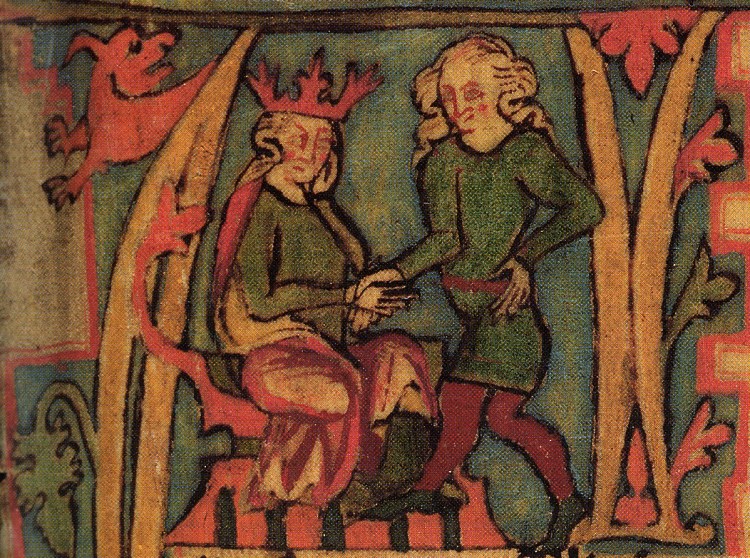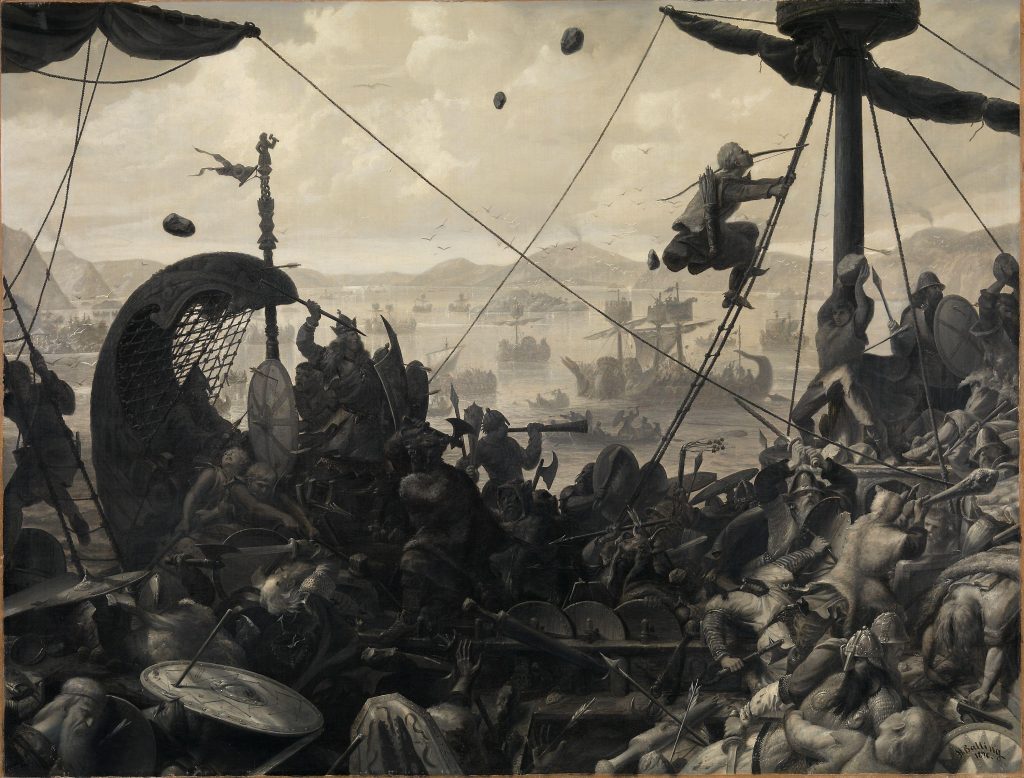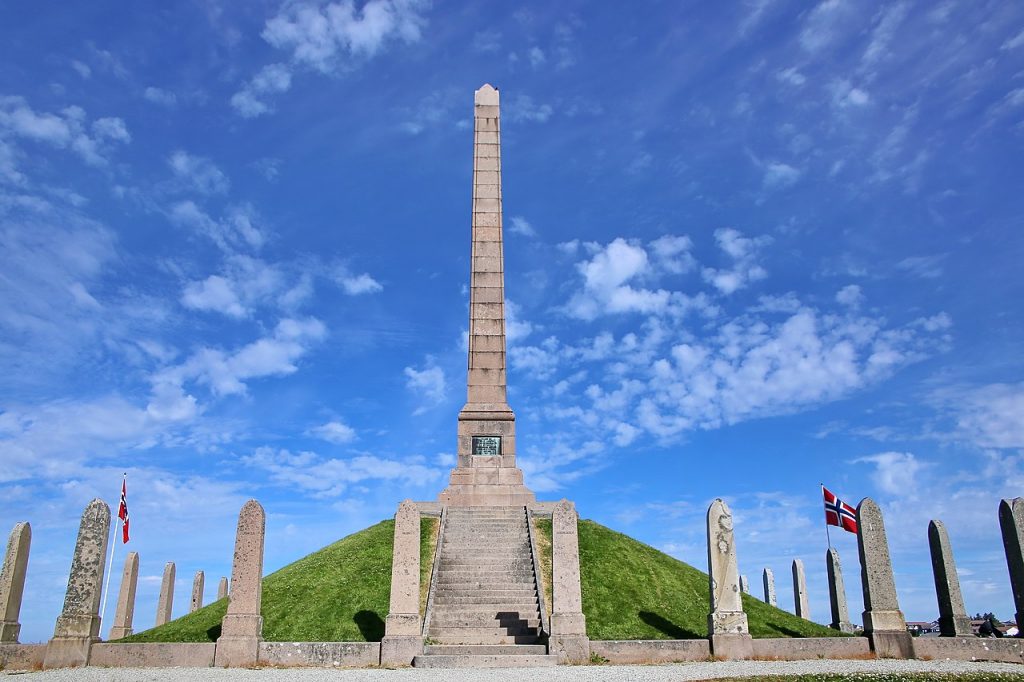
Harald I Fairhair, an illustration from Flateyjarbók, the fourteenth-century Icelandic manuscript
Harald I Fairhair (Harald Hårfagre, c. 850-c.932) the legendary and handsome heir to the Vestfold (Oslo) branch of the long-lasting Yngling dynasty, was ten years old when he became king following his father Halfdan the Black’s accidental death. His rise to power marked a particularly important period in Viking history because the diaspora from Norway and settlement of Iceland (and other lands) was the result of his wars and expansion of the kingdom first forged by Halfdan.
The beginning of that epoch occurred at the great southwestern sea battle at Hafrsfjord in 872, where Harald vanquished a handful of noblemen and chieftains opposing his ambitions. His victory there marked the unification of most of the petty kingdoms of Norway under one ruler and crown and ushered in an era where many peoples abutting the Norwegian Sea were impacted by events occurring in the heart of the Viking world. At the end of his reign and life Harald not only called Norway his realm, but laid claim to the Faroes, the Scottish Northern Isles of Shetland and Orkney (Norðreyjar), the Hebrides (Suðreyjar), and Iceland.[1]
Battles of the 860s
According to the Heimskringla – an early thirteenth-century history of the Norwegian kings written in Old Norse by Icelandic historian Snorri Sturluson, in 867 Harald moved his forces from his “head residence” at Lade (Trondheim) to a place named Solskjel – in the region of Romsdal in the western fjords and there slew two kings in battle. In the saga Snorri quotes a skaldic verse by Torbjørn Hornklove, a poet employed by Harald’s court:
Thus did the hero known to fame,
The leader of the shields, whose name
Strikes every heart with dire dismay,
Launch forth his war-ships to the fray.
Two kings he fought; but little strife
Was needed to cut short their life.
A clang of arms by the sea-shore,—
And the shields’ sound was heard no more.
The following spring Harald raised an army again and returned to Solskjel where another assemblage led by two other kings had amassed in his absence. Again, Harald killed them in a sea battle – further cementing his position as the one true ruler of Norway.[2]
Campaign against the Geats
In the early 870s a dispute between Harald and the Swedish king Erik Anundsson arose resulting in Harald’s forces ravaging parts of Götaland. “King Harald went far and wide through Gautland, and many were the battles he fought there on both sides of the river, and in general he was victorious.” When Harald was satisfied, he appointed his eldest son “Guthorm as chief to defend the country, and left a great force with him.” After hearing this, Harald’s rivals in Norway believed the campaign in Götaland offered them an opportunity to challenge his authority at home, and thus a large force was amassed for a sea battle near present-day Stavanger in southwestern Norway.[3]
Battle of Hafrsfjord
The Heimskringla says that when Harald’s enemies arrived “King Harald was waiting with his forces. A great battle began, which was both hard and long; but at last King Harald gained the day.”

Among those killed were King Eirik of Hordaland, King Sulke of Rogaland and his brother Earl Sote. Thor Haklang, a famed warrior and son of Harald’s main nemesis, King Kiotve the Rich of Agder, was also slain after he “laid his ship against King Harald’s, and there was above all measure a desperate attack…” According to the skald Hornklove, foreign fighters were among King Kiotve’s forces:
A gallant sight it was to see
Their fleet sweep o’er the dark-blue sea;
Each war-ship, with its threatening throat
Of dragon fierce or ravenous brute
Grim gaping from the prow; its wales
Glittering with burnished shields, like scales;
Its crew of udal men of war,
Whose snow-white targets shone from far;
And many a mailed spearman stout
From the West countries round about,
English and Scotch, a foreign host,
And swordsmen from the far French coast.[4]
The Great Scattering
In the aftermath of the decisive battle the saga says “King Harald met no opposition in Norway, for all his opponents and greatest enemies were cut off. But some, and they were a great multitude, fled out of the country, and thereby great districts [overseas] were peopled.”[5]

Some of those districts included areas that Norwegians and other Vikings had been colonizing for a hundred years, such as the Hebrides – known among the Norse as the Sudreys (Suðreyjar), which meant “southern islands.” Other recently discovered places like Iceland were just beginning to feel the effects of Harald’s victory at Hafrsfjord. The twentieth-century professor of Scandinavian literature, Loftur Bjarnason, articulated why so people many left Norway by explaining that Harald gave those defeated three choices: they could “swear allegiance” but “forfeit any inherited rights and privileges including the ancient right to inherit property.” The second option was to have one’s head cut off, and the third was to leave the country forever:
The first choice was really no choice at all for men who had from time immemorial considered themselves free men. It would mean surrendering that which they valued more than life itself. No more could own land in the own name or pass it on to their sons. Few of the real leaders accepted the first alternative. The second choice had somewhat more appeal, especially to the younger, unmarried men. Some wonderful stories are told about how they joked with each other while waiting their turn to be decapitated. By far the greater number of responsible former nobles and landowners, however, accepted the third alternative and left the country.
As a result, the populations of entire areas of Norway were reduced by a flood of proud emigres who in Bjarnason’s words represented “the most aggressive, the most gifted, and most cultured men of the country…” Many of them “fled first to the Norwegian possessions overseas, that is, to Ireland, Scotland, England, the Isle of Man…”[6] And so it was, King Harald Fairhair, the victor at Hafrsfjord, uniter of Norway, became the great scatterer of Vikings across the island realms of the Norwegian Sea.
[1] See: Bruce Lincoln, Between History and Myth: Stories of Harald Fairhair and the Founding of the State (Chicago: University of Chicago Press, 2014). Norway celebrated its millennium in 1872.
[2] Samuel Laing, The Heimskringla or the Sagas of the Norse Kings From the Icelandic of Snorre Sturlason, Vol. 1 (New York: Scribner & Welford, 1889), 350-354.
[3] Ibid. 362
[4] Ibid. 363-4.
[5] Ibid. 365.
[6] Loftur Bjarnason, “The Land of Song and Saga,” Brigham Young University Studies, 9, no. 2 (1969), 211.

Would you be interested in participating in a podcast discussion?
If so, you can reach me @ https://rebirthoftheword.com/contact-info/
It seems like there are some common interests, so let me reciprocate by sharing this with you; you may find this intriguing.
Here’s my work.
http://www.rebirthoftheword.com